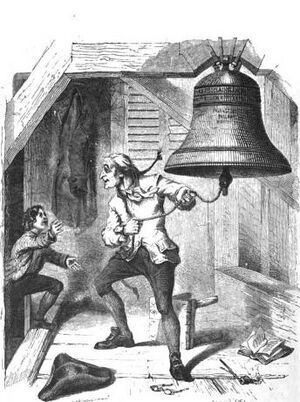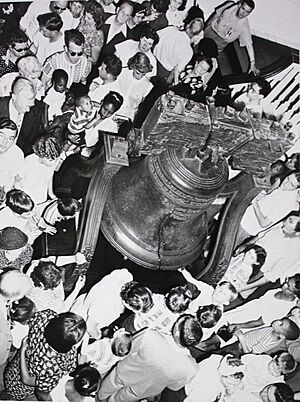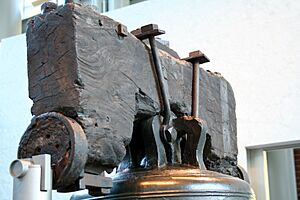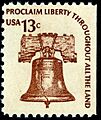Liberty Bell facts for kids
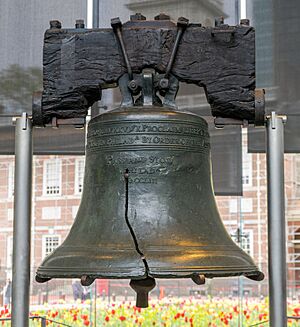
The Liberty Bell outside Independence Hall in Philadelphia in April 2017
|
|
| Coordinates | 39°56′58″N 75°9′1″W / 39.94944°N 75.15028°W |
|---|---|
| Location | Liberty Bell Center Philadelphia, Pennsylvania, U.S. |
| Designer | Whitechapel Bell Foundry |
| Type | Tower bell |
| Material | 70% Copper, 20% Tin, 10% other metals |
| Width | 3.82 ft (1.16 m) (circumference is 12 ft (3.7 m) around the lip, 7.5 ft (2.3 m) around the crown) |
| Height | About 4 ft (1.2 m) |
| Completion date | 1752 |
| 2,080 pounds (940 kg) | |
The Liberty Bell, originally known as the State House Bell, is a famous symbol of American independence. It is located in Philadelphia, Pennsylvania. This historic bell was first hung in the Pennsylvania State House, which is now called Independence Hall. Today, you can see it displayed in the Liberty Bell Center, just across the street.
In 1752, leaders in Pennsylvania asked for this bell to be made. It has a special message carved into it: "Proclaim LIBERTY Throughout all the Land unto all the Inhabitants Thereof." This quote comes from an old Bible verse (Leviticus 25:10). When the bell first arrived in Philadelphia, it cracked the very first time it was rung! Two local craftsmen, John Pass and John Stow, had to melt it down and recast it twice to fix it. At first, the bell was used to call lawmakers to meetings and announce important public events.
After World War II, the National Park Service became responsible for looking after the Liberty Bell, though Philadelphia still owns it. The bell has grown into a powerful symbol of freedom. It has even been a place where people gather for protests. In 2003, the bell was moved to its current home. Over the years, the Liberty Bell has appeared on coins and stamps. It has also been used in many different products and advertisements.
Contents
The Liberty Bell's Journey Through History
Since Philadelphia was founded in 1682, the city used a bell to tell people about important news or dangers. The first city bell hung from a tree behind the Pennsylvania State House, which we now call Independence Hall. People said that William Penn, who founded Philadelphia, brought this original bell to the city. By 1751, Philadelphia was growing fast. City leaders wanted a better bell that could be heard from farther away. Isaac Norris, a leader in Pennsylvania's government, ordered a new bell. He asked for a "good Bell of about two thousands pound weight" from a company in London.
Robert Charles ordered the bell from Thomas Lester's company, later known as the Whitechapel Bell Foundry. It cost about £150, which was a lot of money back then. The bell arrived in Philadelphia in August 1752.
First Crack and Recasting the Bell
When the bell was first tested, it cracked on the very first strike! Philadelphia officials tried to send it back to London, but the ship captain couldn't take it.
Two local metalworkers, John Pass and John Stow, offered to fix the bell. They broke the bell into small pieces and melted it down. They decided the metal was too weak, so they added about ten percent more copper to make it stronger. By March 1753, the new bell was ready.
City officials planned a big celebration to test the recast bell. But when it was struck, the sound was terrible! One person said it sounded like two coal scuttles banging together. People made fun of it, so Pass and Stow quickly took the bell away to recast it again. In June 1753, the bell was finally finished. This time, the sound was good enough, even though Norris still didn't love it. The bell was then hung in the steeple of the State House that same month.
The Bell During the American Revolution
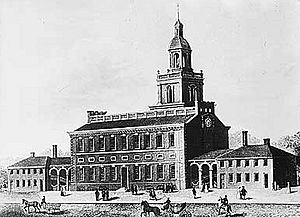

Because they weren't completely happy with the first bell, Norris ordered a second one. He also asked if the London company would take back the first bell. But in 1754, the government decided to keep both bells. The new bell was used for the tower clock, while the old bell (the Liberty Bell) was used to call lawmakers to meetings.
As the American Revolutionary War got more intense, people in Philadelphia worried. They knew the British Army might melt down the bell to make weapons if they found it. On September 11, 1777, these worries grew after George Washington and the Continental Army lost the Battle of Brandywine. This left Philadelphia, the capital of the revolution, unprotected. The city quickly got ready for a British attack.
The Liberty Bell and other important bells in Philadelphia were quickly taken down. They were loaded onto wagons and sent with guards to Bethlehem, and then to Zion German Reformed Church in Allentown, Pennsylvania. In Allentown, the Liberty Bell was hidden under the church's floorboards. This happened just as the British soldiers were entering Philadelphia.
The bell stayed hidden in Allentown for nine months. In June 1778, after the British left Philadelphia, the bell was brought back. The steeple of the State House was in bad shape, so it was taken down and rebuilt. The bell was stored away until 1785, when it was hung up again to be rung.
After Washington and the Continental Army won the Revolutionary War, the bell was placed on an upper floor of the State House. It was rung on Independence Day, Washington's Birthday, and Election Day. It also rang to call students at the University of Pennsylvania to their classes. Between 1785 and 1799, when Pennsylvania's capital moved to Lancaster, the bell called state lawmakers to their meetings. Later, when Pennsylvania wanted to tear down the State House, the City of Philadelphia bought the land, the State House, and the Liberty Bell for $70,000.
The Bell in the 1800s
No one knows exactly when or how the Liberty Bell first got its famous crack. But we know it happened in the early 1800s, likely between 1817 and 1846.
By 1848, people were very interested in the bell. The city decided to move it to the Assembly Room on the first floor. This was the room where the Declaration of Independence and the U.S. Constitution were discussed and signed. The city built a fancy stand for the bell. The Liberty Bell was displayed on this stand for the next 25 years.
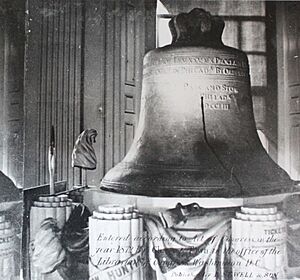
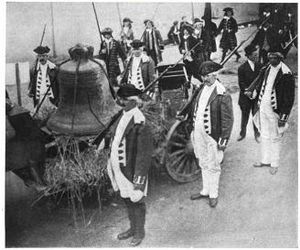
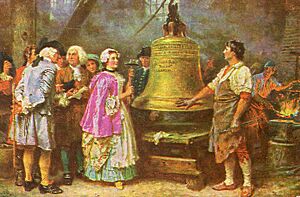
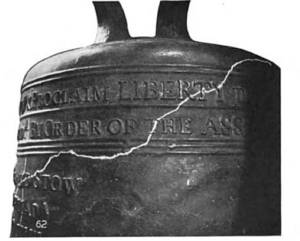
In 1876, Philadelphia officials talked about what the bell should do for the nation's 100th birthday party, the Centennial Exposition. Some wanted to fix it so it could ring, but this idea was not chosen. The people in charge of the bell decided that it probably wouldn't sound good even if fixed. They also felt that the crack had become a part of the bell's special story. Instead, a copy of the bell was made. This "Centennial Bell" weighed 13,000 pounds, representing 1,000 pounds for each of the Thirteen Colonies. It was made from four melted-down cannons: one from each side of the Revolutionary War and one from each side of the American Civil War. This new bell was rung at the Exposition on July 4, 1876. It was later recast to improve its sound and is now attached to the clock in the steeple of Independence Hall.
Between 1885 and 1915, the Liberty Bell traveled to seven different events and celebrations. Each time, the bell went by train. The train made extra stops along the way so that local people could see it. By 1885, the Liberty Bell was known everywhere as a symbol of freedom. Large crowds gathered to see the bell at every stop.
People in Philadelphia started to dislike the idea of sending the bell to other cities. It came back from Chicago with a new crack, and each new trip suggestion faced more and more opposition. It was also discovered that the bell's private guard had been cutting off small pieces for souvenirs! Because of this, Philadelphia put the bell inside a glass-fronted oak case.
In 1898, it was taken out of the glass case and hung from its frame again in the tower hall of Independence Hall. This room was its home until the end of 1975. A guard was placed near the bell to stop people from chipping off pieces for souvenirs.
By 1909, the bell had been on six trips. Its crack got worse, and souvenir hunters had chipped off pieces, making it lose over one percent of its weight. In 1904, its weight was reported as 2,080 pounds.
The Bell in the 1900s and Today

After World War II, the City of Philadelphia agreed to let the federal government take care of the bell and Independence Hall. However, Philadelphia still kept ownership.
After the war, the bell became a symbol of freedom during the Cold War. In the 1960s, the bell was a place for many protests. People protested for the civil rights movement and for or against the Vietnam War.
Liberty Bell Center
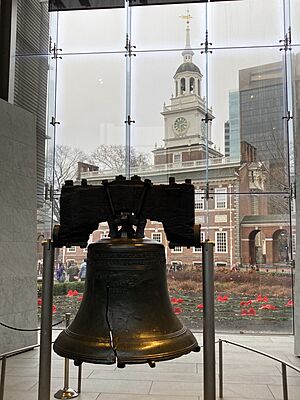
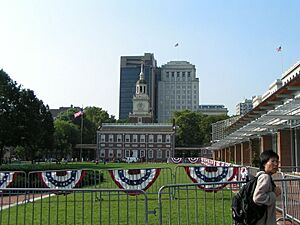
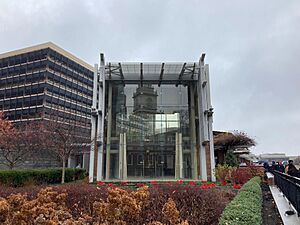
In 1995, the National Park Service started planning a new design for Independence Mall. They hired a company called Olin Partnership to create a new plan. This team included architect Bernard Cywinski, who designed the new Liberty Bell Center (LBC). Cywinski's design was shown in early 1999. The new building was much bigger than the old one. It allowed for more exhibits and a visitor center. The new LBC building also covered part of the old President's House, which was the "White House" for George Washington and John Adams.
The new Liberty Bell Center opened on October 9, 2003, just hours after the bell was moved inside. It is next to a marked outline in the pavement showing where Washington's slave quarters once stood. The address is 526 Market Street.
Inside the Liberty Bell Center, visitors walk through several exhibits about the bell before they see the Liberty Bell itself.
Liberty Bell's Legacy and Commemorations
In 1950, as part of a "Liberty Bell Savings Bonds" effort, 55 copies of the Liberty Bell were made. These bells were for the 48 states, Washington D.C., and the territories. They were made in France by the Fonderie Paccard company. These bells were meant to be displayed and rung on patriotic holidays. Many of them are now located near state capitol buildings.
The Liberty Bell appeared on a special coin in 1926 to celebrate 150 years of American independence. Its first time on a regular coin was on the back of the Franklin half dollar, made between 1948 and 1963. It also appeared on the Bicentennial design of the Eisenhower dollar, shown against the moon.
On the 150th anniversary of the Declaration of Independence in 1926, the U.S. Post Office released a special stamp showing the Liberty Bell. This stamp was for the Sesquicentennial Exposition in Philadelphia. However, this stamp actually shows the replica bell that was at the entrance to the exposition grounds.
Interesting Facts About the Liberty Bell
- The Liberty Bell now weighs 2,080 pounds.
- Its metal is mostly copper (70%) and tin (25%). The rest is made of lead, zinc, arsenic, gold, and silver.
- Many people believe the Liberty Bell rang on July 4, 1776, when the Declaration of Independence was read. However, there is no strong proof to confirm this.
- The bell got its large crack after many years of use. A big widening of the crack happened in 1846 during a celebration for George Washington's birthday.
- Walt Disney World has a copy of the Liberty Bell in Liberty Square at the Magic Kingdom. This copy was made from a mold of the real Liberty Bell in 1989.
- An image of the Liberty Bell appears on the current $100 bill. The image changes color depending on how you hold the bill.
Images for kids
-
Bicentennial dollar, 1976 issue, reverse
See also
 In Spanish: Campana de la Libertad para niños
In Spanish: Campana de la Libertad para niños
- Liberty Bell Memorial Museum, located in Melbourne, Florida
- Liberty Bell Ruby, a huge ruby shaped like the Liberty Bell
- Margaret Buechner wrote a song for a choir and orchestra called Liberty Bell. It uses a 1959 recording of the actual bell.
- Freedom Bell in Berlin, Germany – This bell was a gift from Americans to Berlin in 1950. It was a symbol of fighting for freedom and against communism in Europe.
- The superhero Liberty Belle gets her powers from the ringing of the bell.
- The Freedom Bell, American Legion, a copy of the Liberty Bell, is in front of Union Station in Washington, D.C.. It traveled across the United States on the 1975–76 Bicentennial American Freedom Train.
- The Rhodesian Independence Bell, a copy of the Liberty Bell paid for by American donors to celebrate Rhodesian independence.
- The Tsar Bell, a very large Russian bell from the early 1700s, famous for its huge size and its damaged state.


